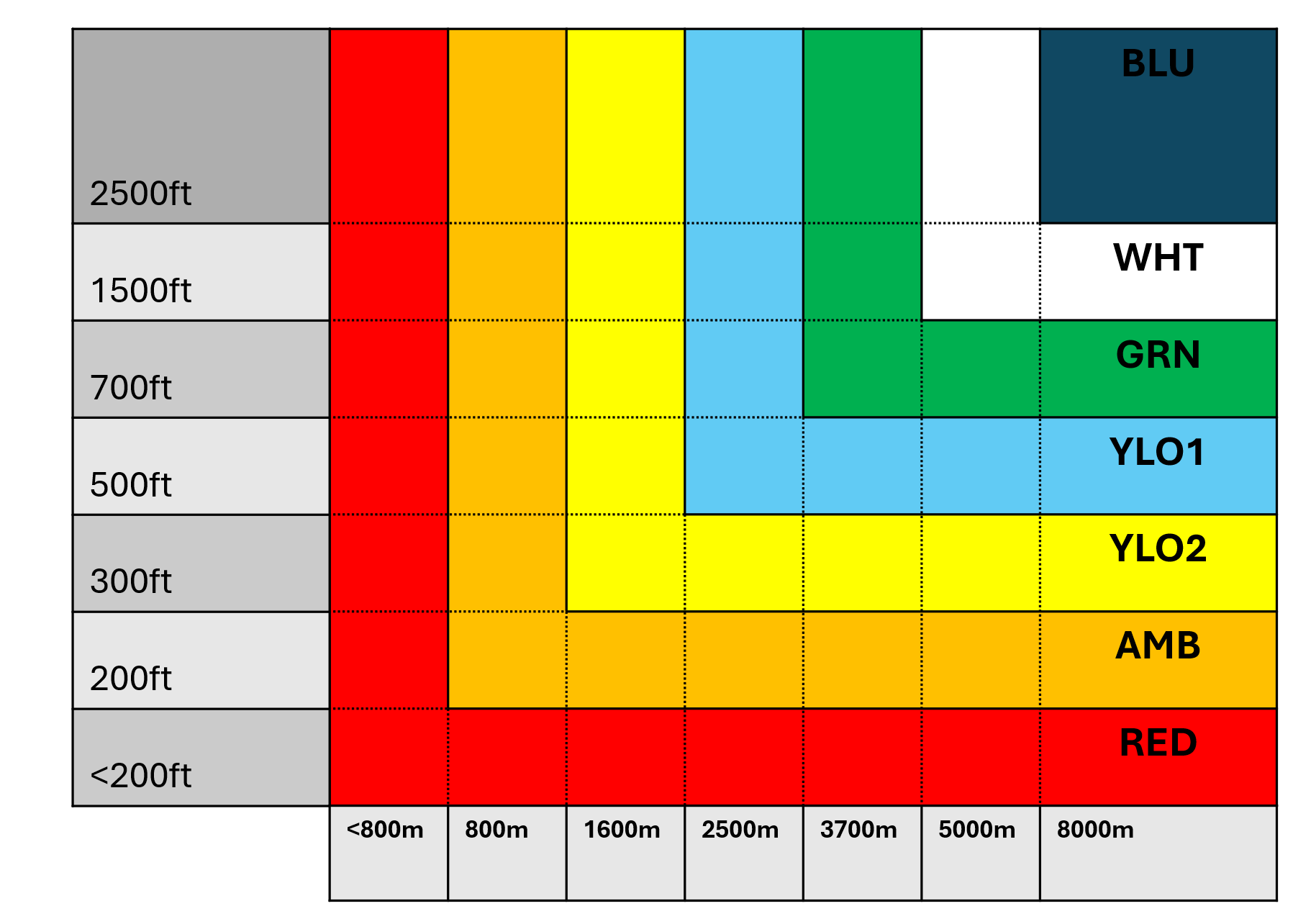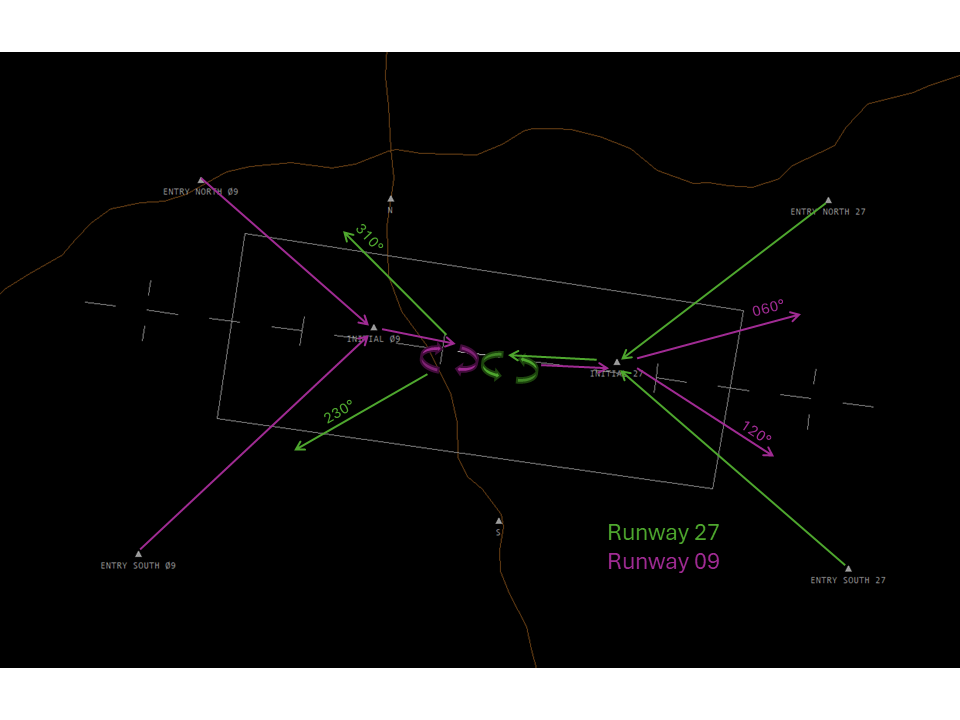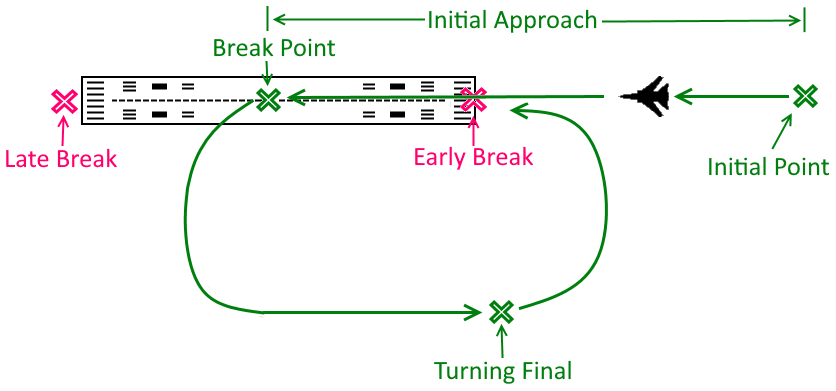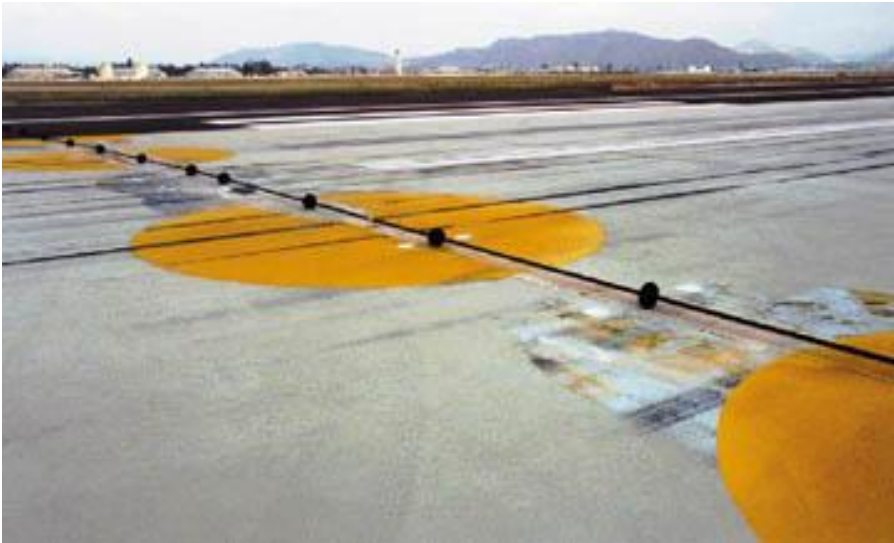Military Tower
In general, Military Airfields work a little different to the airports that you might be familiar with. They have a control tower and a radar station that you might call approach. However, the radar airspace is not nearly as high as the approach airspace you are familiar with. But first we will look at the Tower position.
Reference Documentation
Charts and Maps for German Military airfield and Airspace can be found on the Mil AIP (www.milais.org).
Weather Information
Airfield color states
As opposed to normal TWRs, military TWRs do not offer an ATIS. Instead, the weather information is given as a color code. Additionally, the QNH and the active runway have to be communicated to the pilot. The color codes and the respective weather are listed below. In case the visibility and cloud ceiling color do not match, the color corresponding to the worst weather of the two is published.
- Blu+: cloud ceiling (more than half of the sky is covered) below 20000ft. (not BKN or OVC below 20000ft)
- Blu: visibility 8000m, cloud ceiling at least 2500ft
- WHT: visibility 5000m, cloud ceiling at least 1500ft
- GRN: visibility 3700m, cloud ceiling at least 700ft
- YLO1: visibility 1600m, cloud ceiling at least 500ft
- YLO2: visibility 1600m, cloud ceiling at least 1600ft
- AMB: visibility 800m, cloud ceiling at least 800ft
- Red: visibility less than 800m, cloud ceiling less than 200ft or VV//
- Black: Runway closed for other reason than weather
White is still considered sufficient for VMC operations while Green requires IFR procedures.
Formation Flights
Formation flights shall be controlled/cleared as a single aircraft unless the formation leader requests otherwise.
Radio communication flow is strictly between the formation leader and the controller.
The controller should expect a radio roll call from all wingmen before being contacted by the leader. (i.e: NATO11 check... 12... 13... 14. Laage Tower NATO11)
Should a call be addressed to a specific wingman, the controller must use the aircraft callsign including the sequence number. (i.e: NATO13 Laage Tower squawk stand-by)
The responsibility for landing interval between elements of a formation flight rests with the pilots in the formation.
Pilots may transmit codewords when airborne to confirm the visual and radar contact within the formation. These codewords are:
- SHINING Wingman claims a radar lock on the leader
- BUDDY SPIKE (SPOT) Leader confirm the radar lock (via ECM)
- TIED ON Remaining locked on the leader
- IN VISUAL TRAIL Keeping visual
- HOLDING HANDS Aircraft are joined up.
TAXI
Taxi clearance
Taxi clearance shall be obtained prior to taxiing. Formation leaders may obtain taxi clearance for their entire flight. A clearance to taxi to the runway authorizes the aircraft to cross all taxiways that the taxi route intersects except the assigned takeoff
runway. Pilots shall read back all hold/hold short instructions received during taxi.
Furthermore, military airfields rarely have multiple taxiways and if they do, they have standardized taxi routes. Therefore, you do not need to name taxiways when giving the taxi clearance. You also have to ask the DFS radar station for a departure release before issuing a takeoff clearance due to the low radar airspace.
Overtaking
No taxiing aircraft shall overtake or pass another aircraft except with tower approval.
Taxi speed
All aircraft shall be taxied at a safe rate of speed and under positive control of the pilot at all times.
Last chance area
Military airfield operating jet aircraft are equipped with Last chance areas next to the runway. These areas can be used by pilots to perform the Last Chance Check on the aircraft before departure or, if they are equipped with weapons, to pull the safety pins of the weapons. Tower doesn't need to instruct the pilot to taxi to this area, if a pilot requires to stop there, he will do this on his own.
Last chance area at Laage (ETNL)
Alert Scramble (QRA)
Quick Reaction Alert (QRA) is a state of readiness and responsiveness maintained by air forces and other military bodies worldwide. Its purpose is to deter, detect, and counter threats promptly.
When the order to take-off (scramble) is triggered, the alert aircraft (single or in pair) have a minimum delay to take-off. Therefore, they shall be prioritized over all other traffic.
TAKE-OFF
ATC Clearance
Aircraft departing on IFR flight plans must be provided with their ATC clearance on Tower control. Departing pilots shall read back clearances differing from the filed flight plan. Standard procedure is to give the aircraft an taxi instruction before the IFR clearance.
Just like a DFS Tower, the military Tower is in control of a CTR and all ground movements. However, it cannot issue IFR clearances. Instead IFR clearances are requested at the responsible DFS station via telephone. First, the DFS station transmits the clearance to the military Tower that confirms it with his initials (No readback for the DFS Station required). Then the military Tower transmits the clearance to the pilot, who reads it back to the Tower. In real life the military Tower first calls the military Radar who then calls the DFS station, but I think we can skip this step ;)
IFR clearances are similar to those you are used to. They simply contain the point that the aircraft is cleared to, "first fix" (A fix somewhere on the flight plan), the SID/OID, a squawk and instructions whom to contact when airborne. They may contain a flight level but that is often left blank for convenience. Military Aircraft usually aren't instructed to follow a SID but an OID (operational instrument departure) which is similar to a SID. They are usually named with the last two letters of the ICAO code of the airport and a number (e.g. NL19, pronounced November-Lima-one-niner). You can find these on Navigraph and in the AIP. However, if the SIDs have names or if the aircraft is flying according to a civil aviation flight plan (fixes and airways) then you should assign a SID if available (like ETOU or ETNL).
Takeoff Clearance
Another specialty of Military TWRs is that the wind is given during line up and take off. This is because especially formation flights have a lower crosswind limits for formation takeoffs and the pilots need to know before line up if they can depart as a formation or if they need to depart individually.
Frequency Changes
Military aircraft may receive an radio handoff to the next radar station with the takeoff clearance.
Departures and Arrivals
- IFR Aircraft departing IFR will be transferred to Approach controller as soon as possible or allready on the runway.
- VFR Aircraft departing VFR will proceed through the published trajectories to the CTR exit point or leave the CTR to the top.
Most Military airports have special VFR Arrival and departure routes published in the VFR Charts. These VFR Jet arrivals and VFR Jet departures are used for military Jets. The Jet arrival normally consists of one mandatory reporting point outside the CTR and its respected Initial point in front of the runway.
e.g. Jets will enter Laage CTR via an Entry at 1700 ft and up to 300 kt.
It’s important to remember that Jets on the VFR Jet arrival will normally overfly the airport to make an Overhead Approach Maneuver and then join the final as published in the chart!
Visual Jet Arrival and Departure routes in Laage (ETNL)
Circuit and Landing
Aircraft engaged in the airfield circuit must be in radio communication with the ATC Tower controller.
Before landing, when turning on base or when on final, a pilot must declare his landing gear is down and locked by the expression:
“GEAR DOWN AND LOCKED”.
When a Pilot forgets to declare the expression mentioned above, the ATC must request confirmation by using the expression: “Confirm gear down and locked?” or “Check gear down and locked”
Overhead Approach Maneuver (Break arrival)
The Overhead Approach Maneuver is a visual procedure that is used at military airports for the use of military jets flying VFR. These jets usually carry a lot more kinetic energy than civil aircraft do and need to dissipate that energy before landing. For this purpose the procedure is published on military airports. This is equivalent to a carrier approach. You can find the charts in the German Military AIP designated as VAD. Some examples for airports with this procedure are ETHC, ETNG, ETSB, ETSH, ETNL, ETNT but there are more. In these charts you will always find an Entry Point and a predetermined route that leads to the "Initial". The "Initial" is a point about 2 NM from the runway.
The procedure after the Initial is depicted on the right. The Military jet will approach with 300 kts indicated airspeed and descend to the published altitude of the procedure. Usually, the published altitude is about 1000ft-2000ft higher than the airport elevation. The aircraft will then overfly the runway until reaching the break point. The standard break point is in the middle of the runway upon which the aircraft will enter a 3G turn to either side and decelerate in that turn. It is possible to fly this procedure faster but then the pilots needs to pull harder and thus increase the centrifugal force in the turn. In simple words: The harder the pilot pulls the better the deceleration.
The jet will then continue in the traffic circuit while still decelerating. On downwind the pilot also puts down flaps and gear. The pilot should reach the approach speed before initiating the final turn. After about half of the final turn the jet will start descending towards the runway on which it will land. As you can see in the picture, the break can be flown early and late which gives ATC the opportunity to sequence aircraft in case ATC deems it necessary, however, because this is a visual maneuver, the sequencing should be done with traffic information and numbering.
In general, it is very easy to dissipate energy in this maneuver which is why it is preferable for military jets. Furthermore, this procedure minimizes the time that aircraft spend low and slow, thus, minimizing the time that these jets are most vulnerable.
Important points:
- Initial is a mandatory reporting point
- On downwind the pilot can be asked whether he intends to do a touch and go, low approach or full stop landing.
- This procedure is an easy way to dissolve a formation for individual landings if requested by the pilot. The formation will continue to the break point like with the normal procedure. At the break point the first aircraft will enter the break turn. After a few seconds the second aircraft will enter the break turn and this will continue until the last aircraft enters the break turn and the formation proceeds to land individually.
- As always with military jets: On Crosswind or final the pilot has to be reminded to check the landing gear "Check gear down" unless he has reported gear down before that point.
- To reemphasize: If published, this is the way that visual approaches ought to be flown in military jets unless a "straight in" visual approach is requested and accepted by ATC.
If you let a formation fly this overhead approach then they will break individually during the procedure and also land individually one after another. When the first aircraft is on downwind you can ask the pilot about his intentions. If he wants to do a final landing then you can ask all other pilots of the formation if they also want to do a final landing. If they confirm that they want to perform the final landing, you can clear the whole formation for landing at once (e.g. "wind 25005kts, runway 27 cleared to land as formation").
Below you find a Phraseology example for a published overhead approach. At this point ATC should already be in contact with the aircraft, should already have told the aircraft the runway in use, QNH and color code.
| Station | Overhead Approach Maneuver |
| ETNT_TWR | GAF123, enter CTR via Entry East |
| GAF123 | GAF123, enter CTR via Entry East |
| At Entry East | |
| GAF123 | GAF123 at entry east, 1500ft |
| ETNT_TWR | GAF123, Roger, report initial |
| GAF123 | GAF123, wilco |
| At Initial | |
| GAF123 | GAF123, Initial |
| ETNT_TWR | GAF123, number 2, following EUFI on right downwind 26 |
| GAF123 | GAF123, Roger |
| On Downwind | |
| ETNT_TWR | GAF123, report intentions |
| GAF123 | GAF123, Full Stop Landing |
| ETNT_TWR | GAF123, roger, wind 25005kt runway 26 cleared to land, check gear down |
| GAF123 | GAF123, runway 26 cleared to land, gear down |
In case you ever want to do this on an airport that has no published procedure for the overhead approach maneuver, you should tell the pilot the pattern altitude and the direction of the pattern. You also have to tell the pilot which initial to report(e.g. "runway 26, pattern altitude 1500ft, right turns, report 2 NM initial").
Transporter Tactical Approach
There isn't much to talk about for transporter approaches. In general Military transporters try to spend as little time as possible close to the ground. Therefore, the standard combat approach for a transporter is an approach that is as steep as possible. In general, transporters prefer to maintain altitude as long as possible. They will configure for landing like landing gear down, flaps and even speed brakes and then descend for the runway with up to 4000 ft per minute.
Additionally there are Transporter Tactical Approaches called TAC 1, TAC 2, and TAC 3 which can be seen in the picture of the right.They are designed to make the approach direction of a transporter less predictable by changing between TAC 1, 2 and 3. TAC 1 is basically the straight-in approach. TAC 2 is just like a circling approach and TAC 3 an approach orthogonally to the runway. TAC 3 has two directions it can approach from so additionally North, South, East and West should be added to specify which direction is used
Special Activities
Operation of aircraft arresting systems
There are 2 types of runway arresting systems used for different purposes.
- Aircraft Arresting Cables: Primarily used for tactical military aircraft, such as fighter jets and attack planes fitted with a hook.
- Aircraft Arresting Barriers: Also primarily used for tactical military aircraft
Normally, the barriers will be maintained in the down position. When the barrier has been raised for any emergency situation or if the barrier is under maintenance in a raised position, all take-off must be stopped.
Another Example
Below you find an example IFR flight from initial call to handoff to the military radar. We assume the pilot has filed a flight plan which he should do.
| Station | IFR from startup to departure |
| GAF123 | ETNT_TWR, GAF123, Moin |
| ETNT_TWR | GAF123, ETNT_TWR, Moin |
| GAF123 | GAF123, request taxi |
| ETNT_TWR | GAF123, taxi to holding point runway 26, QNH 1013 |
| GAF123 | GAF123, taxi to holding point runway 26, QNH 1013 |
| During Taxi ETNT_TWR calls EDWW_W_CTR | |
| EDWW_W_CTR | Moin |
| ETNT_TWR | Moin, ETNT_TWR, request clearance for GAF123 |
| EDWW_W_CTR | GAF123 is cleared to Schleswig via EMPIT, squawk 2116 |
| ETNT_TWR | GAF123 is cleared to Schleswig via EMPIT, squawk 2116 |
| EDWW_W_CTR | correct |
| Back on frequency | |
| ETNT_TWR | GAF123 report ready to copy clearance |
| GAF123 | GAF123, ready |
| ETNT_TWR | GAF123, cleared to Schleswig via NT126 left turn EMPIT, squawk 2116, when airborn contact ETNT_APP on xxx.xxx |
| GAF123 | GAF123, cleared to Schleswig via NT126 left turn EMPIT, squawk 2116, when airborn contact ETNT_APP on xxx.xxx |
| ETNT_TWR | GAF123, readback correct |
| Pilot reaches runway and performs pre-departure checks. After pre-departure checks | |
| GAF123 | GAF123, ready |
| ETNT_TWR | GAF123, line up runway 26, wind 25005kts |
| GAF123 | GAF123, line up runway 26 |
| Meanwhile on the phone... | |
| EDWW_W_CTR | Moin |
| ETNT_TWR | Moin, request departure release for GAF123 |
| EDWW_W_CTR | GAF123 released to climb FL70 |
| ETNT_TWR | GAF123 released to climb FL70 |
| Back on frequency | |
| ETNT_TWR | GAF123, climb FL70, wind 25005kts, runway 26 cleared for takeoff |
| GAF123 | GAF123 climb FL70, wind 25005kts, runway 26 cleared for takeoff |
| After take off | |
| ETNT_TWR | GAF123 contact Wittmund Radar on 123.125 |
| GAF123 | GAF123 contact Wittmund Radar on 123.125 |
After this the Radar will identify the aircraft before handing the aircraft over to the responsible DFS station.







